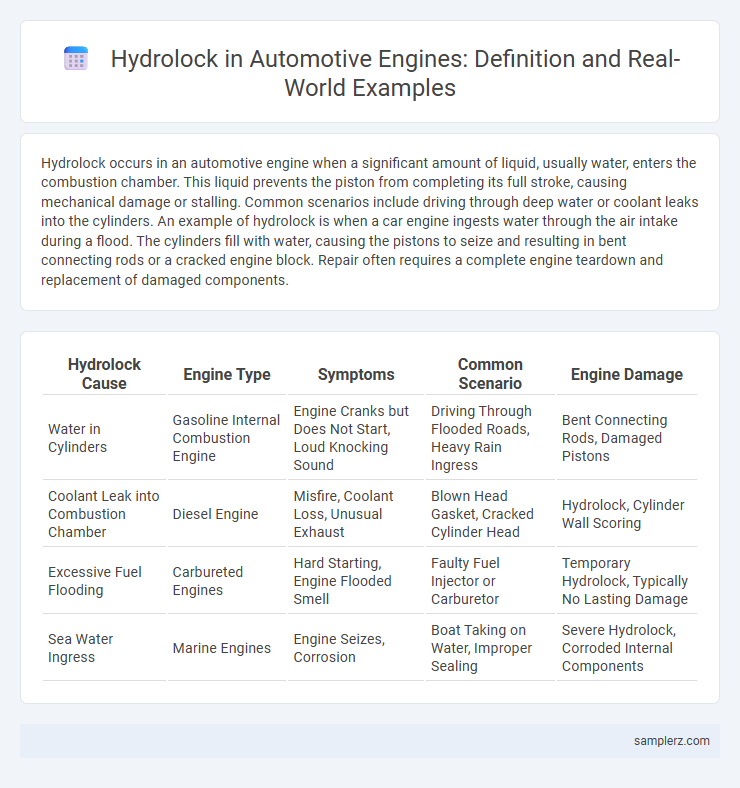Hydrolock occurs in an automotive engine when a significant amount of liquid, usually water, enters the combustion chamber. This liquid prevents the piston from completing its full stroke, causing mechanical damage or stalling. Common scenarios include driving through deep water or coolant leaks into the cylinders. An example of hydrolock is when a car engine ingests water through the air intake during a flood. The cylinders fill with water, causing the pistons to seize and resulting in bent connecting rods or a cracked engine block. Repair often requires a complete engine teardown and replacement of damaged components.
Table of Comparison
| Hydrolock Cause | Engine Type | Symptoms | Common Scenario | Engine Damage |
|---|---|---|---|---|
| Water in Cylinders | Gasoline Internal Combustion Engine | Engine Cranks but Does Not Start, Loud Knocking Sound | Driving Through Flooded Roads, Heavy Rain Ingress | Bent Connecting Rods, Damaged Pistons |
| Coolant Leak into Combustion Chamber | Diesel Engine | Misfire, Coolant Loss, Unusual Exhaust | Blown Head Gasket, Cracked Cylinder Head | Hydrolock, Cylinder Wall Scoring |
| Excessive Fuel Flooding | Carbureted Engines | Hard Starting, Engine Flooded Smell | Faulty Fuel Injector or Carburetor | Temporary Hydrolock, Typically No Lasting Damage |
| Sea Water Ingress | Marine Engines | Engine Seizes, Corrosion | Boat Taking on Water, Improper Sealing | Severe Hydrolock, Corroded Internal Components |
Understanding Hydrolock: What Is Engine Hydrolocking?
Engine hydrolocking occurs when a liquid, typically water or coolant, enters the engine cylinders, preventing the pistons from completing their movement. This condition causes severe mechanical damage due to the incompressible nature of the liquid, leading to bent connecting rods, damaged cylinder walls, or cracked engine blocks. Common causes include driving through deep water or coolant leaks into the combustion chamber, emphasizing the importance of timely maintenance and proper engine sealing.
Causes of Hydrolock in Automotive Engines
Hydrolock in automotive engines occurs when a substantial amount of liquid enters the combustion chamber, preventing the piston from completing its stroke. Common causes include flooding due to a malfunctioning fuel injector, coolant leaks from a blown head gasket, or driving through deep water that enters the air intake system. Engine damage from hydrolock often results in bent connecting rods, cracked engine blocks, or warped cylinder heads, necessitating extensive repairs.
Real-World Hydrolock Incidents: Notable Case Studies
A notable example of hydrolock occurred when a high-performance sports car encountered deep floodwaters during a heavy rainstorm, causing water to enter the engine cylinders and seize the pistons. In another real-world incident, a diesel truck driving through a flooded underpass suffered catastrophic engine failure due to hydrolock, leading to extensive repairs and engine replacement. These cases highlight the critical risk of water ingestion during severe weather events or improper driving through waterlogged areas, emphasizing the importance of avoiding flooded roads to prevent hydrolock damage.
Signs and Symptoms of Engine Hydrolock
Engine hydrolock occurs when water enters the combustion chamber, causing the piston to seize due to incompressible fluid presence. Common signs include sudden engine stalling, a loud knocking or banging noise during startup, and difficulty turning the engine over. Additional symptoms are excessive white exhaust smoke and abnormal engine vibrations indicating internal damage.
Common Vehicles Susceptible to Hydrolocking
Common vehicles susceptible to hydrolocking include sedans, SUVs, and trucks driven through deep water or flooded roads, where engine cylinders can fill with water instead of air. Diesel and gasoline engines in models like the Ford F-150, Toyota Camry, and Jeep Wrangler are frequently impacted due to their design and off-road usage. Hydrolock often occurs during heavy rainstorms or river crossings when water entry into the intake manifold disrupts normal engine combustion and causes severe mechanical damage.
Step-by-Step: What Happens During Engine Hydrolock
During engine hydrolock, water enters the combustion chamber through sources such as a damaged intake manifold or flooded air filter. As the piston attempts to compress the water, which is incompressible, it causes a sudden mechanical obstruction leading to bent connecting rods or cracked pistons. This hydraulic pressure immediately stalls the engine, often causing severe damage to internal components like the crankshaft and cylinder head.
Consequences: Engine Damage from Hydrolock
Hydrolock occurs when water enters the engine cylinders, preventing the pistons from completing their stroke, which can cause severe engine damage. This condition often leads to bent connecting rods, cracked pistons, and damaged cylinder walls, resulting in costly repairs or complete engine replacement. Immediate diagnosis and avoidance of engine cranking are crucial to minimize damage and preserve engine integrity.
Prevention Tips: How to Avoid Hydrolock in Cars
Hydrolock occurs when water enters the engine cylinders, preventing piston movement and causing severe engine damage. To prevent hydrolock, avoid driving through deep water and regularly inspect air intake seals and gaskets for damage. Installing a snorkel and ensuring proper maintenance of the vehicle's intake system helps protect the engine from water intrusion during wet conditions.
Diagnosing Hydrolock: Methods and Tools
Diagnosing hydrolock in an engine involves detecting the presence of liquid within the combustion chamber, typically using techniques like cylinder compression testing and crankshaft rotation analysis. Mechanics employ borescopes to inspect internal engine components visually without disassembly, while diagnostic scan tools help identify unusual sensor readings indicative of hydrolock. Pressure sensors and ultrasonic leak detectors further aid in pinpointing water entry points and assessing cylinder integrity to confirm hydrolock conditions.
Repair and Recovery: Solutions After Hydrolock Occurs
Hydrolock in an engine occurs when water enters the combustion chamber, preventing normal piston movement and causing significant mechanical damage. Repair and recovery involve disassembling the engine to remove water, inspecting and replacing damaged components like bent connecting rods or pistons, and thoroughly drying internal parts to prevent corrosion. Professional engine diagnostics and fluid testing are essential to ensure no residual moisture remains, restoring optimal engine performance and preventing future hydrolock incidents.

example of hydrolock in engine Infographic
 samplerz.com
samplerz.com